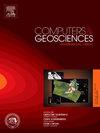Interpretable clustering of PS-InSAR time series for ground deformation detection
IF 4.4
2区 地球科学
Q1 COMPUTER SCIENCE, INTERDISCIPLINARY APPLICATIONS
引用次数: 0
Abstract
Persistent Scatterer Interferometry Synthetic Aperture Radar (PS-InSAR) provides high-precision ground deformation measurements over wide areas. However, analyzing PS time series remains challenging due to complex temporal patterns and the need to consider comprehensive displacement fields to fully characterize ground deformation processes. This study evaluates and compares unsupervised clustering approaches for PS time series analysis, contrasting feature extraction techniques against raw time series methods. We developed an online optimization algorithm for cluster number determination and introduced a custom density-based score (MLRD) for evaluating clustering quality in sparse geospatial datasets. The approaches were tested on Sentinel-1-derived PS data from the landslide-prone Offida municipality (Marche region, Italy), where feature-based methodologies demonstrated superior performance, achieving improvements of one to two orders of magnitude in clustering quality metrics compared to conventional approaches. The multivariate analysis notably outperformed univariate methods, with optimal MLRD () and Calinski–Harabasz scores (194.73) at 50% explained variance, while preserving the physical interpretability of the results. This comprehensive analysis identified coherent deformation clusters extending beyond previously mapped landslide boundaries, demonstrating the effectiveness of multivariate clustering in detecting potentially unstable areas. This methodological framework advances PS time series analysis through robust pattern recognition while enhancing geohazard assessment capabilities, offering a robust foundation for identifying unstable areas and providing quantitative support for improving our understanding of complex ground deformation mechanisms.
PS-InSAR时间序列用于地面变形检测的可解释聚类
持续散射体干涉测量合成孔径雷达(PS-InSAR)在大范围内提供高精度地面变形测量。然而,由于复杂的时间模式和需要考虑综合位移场以充分表征地面变形过程,分析PS时间序列仍然具有挑战性。本研究评估和比较了PS时间序列分析的无监督聚类方法,对比了特征提取技术和原始时间序列方法。我们开发了一种用于确定聚类数量的在线优化算法,并引入了一种基于自定义密度的评分(MLRD)来评估稀疏地理空间数据集的聚类质量。这些方法在来自滑坡易发的Offida市(意大利Marche地区)的sentinel -1衍生的PS数据上进行了测试,在那里基于特征的方法表现出了优越的性能,与传统方法相比,在聚类质量指标上实现了一到两个数量级的改进。多变量分析明显优于单变量方法,在保留结果的物理可解释性的同时,最优MLRD(2.59⋅10−5)和Calinski-Harabasz分数(194.73)在50%的解释方差下达到最佳。这项综合分析确定了超出先前绘制的滑坡边界的相干变形簇,证明了多元聚类在检测潜在不稳定区域方面的有效性。该方法框架通过强大的模式识别推进了PS时间序列分析,同时增强了地质灾害评估能力,为识别不稳定区域提供了坚实的基础,并为提高我们对复杂地面变形机制的理解提供了定量支持。
本文章由计算机程序翻译,如有差异,请以英文原文为准。
求助全文
约1分钟内获得全文
求助全文
来源期刊

Computers & Geosciences
地学-地球科学综合
CiteScore
9.30
自引率
6.80%
发文量
164
审稿时长
3.4 months
期刊介绍:
Computers & Geosciences publishes high impact, original research at the interface between Computer Sciences and Geosciences. Publications should apply modern computer science paradigms, whether computational or informatics-based, to address problems in the geosciences.
 求助内容:
求助内容: 应助结果提醒方式:
应助结果提醒方式:


